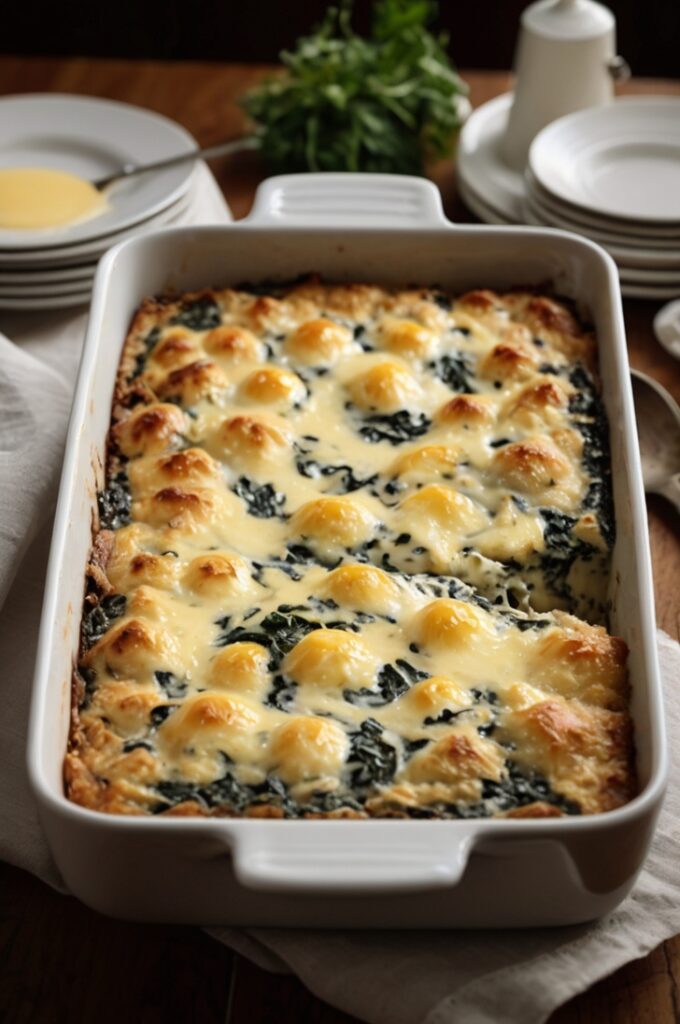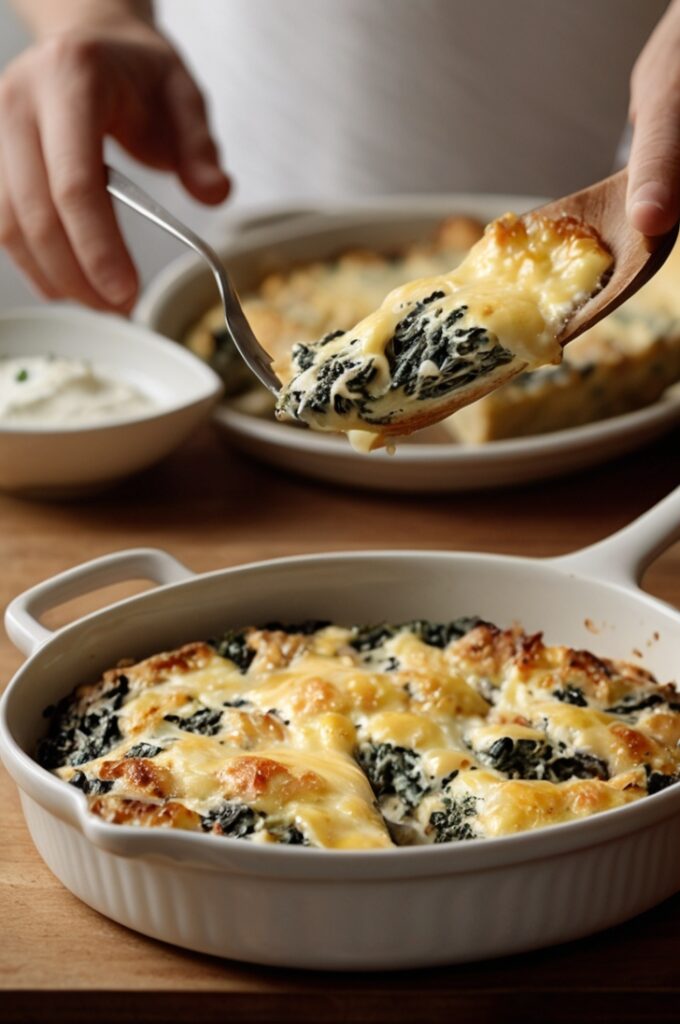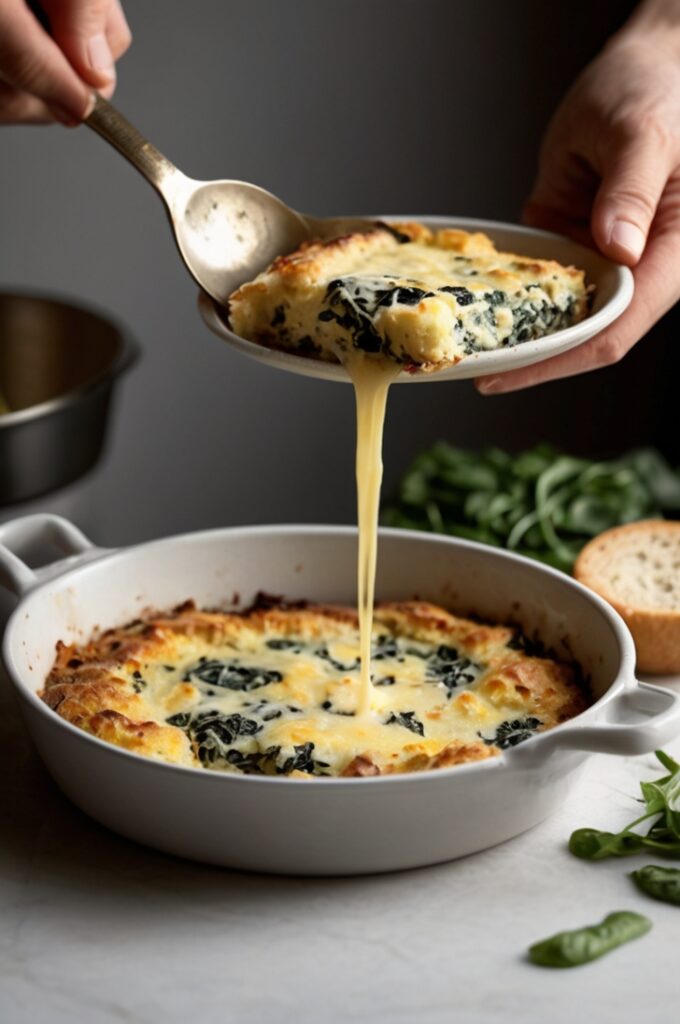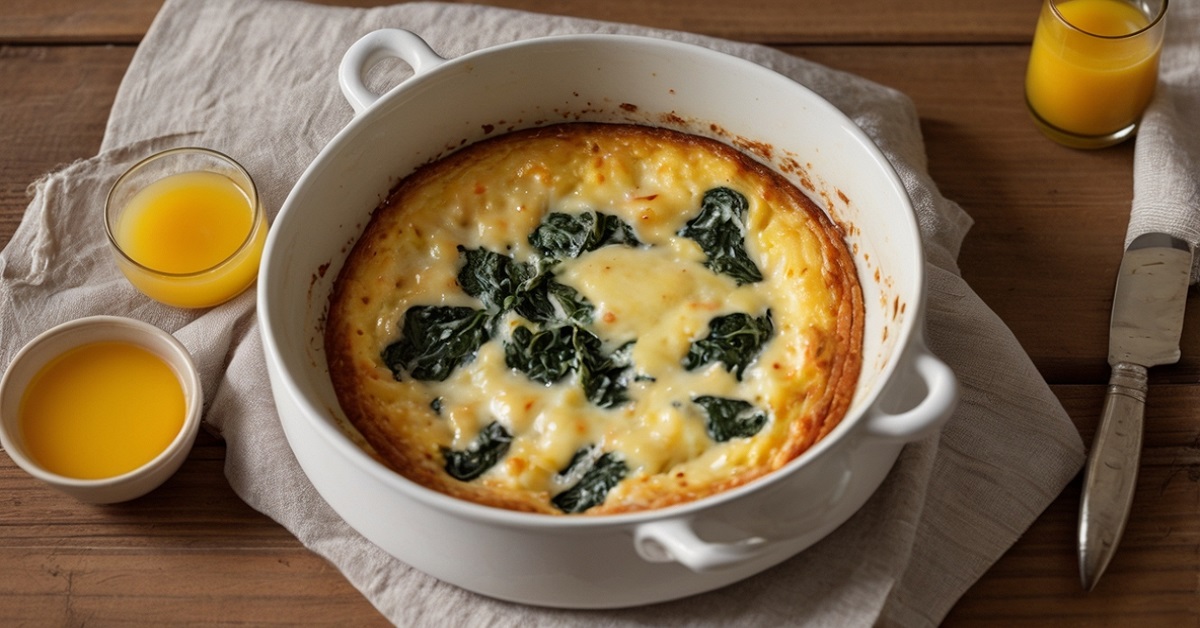Spinach Florentine Breakfast Casserole isn’t just a cozy brunch dish it’s a full-blown morning mood.
The first time I made one for a brunch shift, I was hungover, sweaty, and a little mad at the morning. But the second I pulled it out of the oven, with steam lifting off a blanket of melted cheese and greens, it hit me: this is what Sunday mornings should smell like.
Spinach Florentine breakfast casserole is one of those rare dishes that feels indulgent but also secretly virtuous. It’s loaded with protein, packed with greens, and can be scaled up or down depending on how many tired souls you’re trying to feed. It holds like a champ on a buffet table and actually gets better if you let it rest a bit before slicing. That kinda breakfast? Yeah, it’s a keeper.
This isn’t just your average eggs-and-cheese-in-a-pan. We’re talking layers of flavor: sautéed spinach (fresh, not the slimy canned stuff), sharp cheese, caramelized onions, custardy eggs, and bread that goes from pillowy in the middle to crispy on the edges. And yeah Florentine means spinach, technically. But the way we treat that spinach here? That’s the real flex.
Ingredients & Smart Substitutions

Here’s what you’ll need:
(in order of use, more or less)
- 1 tablespoon olive oil
- 1 small yellow onion, finely chopped
- 3 garlic cloves, minced
- 5 packed cups fresh baby spinach (or about 10 oz)
- 6 large eggs
- 1 ½ cups whole milk (or half-and-half for richer texture)
- 1 teaspoon kosher salt
- ½ teaspoon freshly cracked black pepper
- ¼ teaspoon ground nutmeg (don’t skip it, trust me)
- 4 cups day-old crusty bread, cubed (sourdough, ciabatta, etc.)
- 1 cup shredded Gruyère (or Swiss)
- ½ cup grated Parmesan
- Butter for greasing the baking dish
Substitutions & Ingredient Notes:
Fresh baby spinach is ideal. It’s tender, cooks fast, and has that subtle sweetness. But if you’re in a pinch? Frozen spinach works. Just wring it out like you’re mad at it. Any leftover water will sog the whole thing.
Gruyère brings melty richness and that nutty backbone you want in a savory bake. Don’t got it? A combo of sharp white cheddar and mozzarella will do, but go light on the mozz or it’ll get greasy.
Bread this part matters. Don’t grab sandwich bread. You want something sturdy with chew and holes, like ciabatta or baguette. Day-old is key. Fresh bread gets mushy fast.
Nutmeg? Yes, just a whisper of it. Adds warmth that makes everything taste fuller without being obvious. A microplane is your friend here. Pre-ground stuff is okay but loses its soul fast.
Step-by-Step Instructions with Chef Tips
1. Sauté the aromatics.
Heat olive oil in a skillet over medium heat. Toss in chopped onions and let them sweat until translucentabout 5 minutes. Add garlic and cook another 30 seconds until fragrant but not browned.
Pro tip: Add a pinch of salt early to coax out moisture from the onions faster. Helps build flavor from the base up.
2. Wilt the spinach.
Add fresh spinach by the handful, stirring as it wilts down. It’ll seem like a mountain at first, but don’t worry it cooks down to a couple mouthfuls of glory. Once wilted, set aside to cool slightly.
Mistake to avoid: tossing in all the spinach at once. It’ll steam, not sauté. Layer it in and stir.
3. Make the egg custard.
In a large bowl, whisk eggs until smooth. Add milk (or half-and-half), salt, pepper, and nutmeg. Whisk again until fully combined.
Too many people skip seasoning the eggs. Don’t do that. The whole bake hinges on this.
4. Assemble the casserole.
Grease a 9×13-inch baking dish with butter. Add the cubed bread in a single layer. Scatter the sautéed spinach and onion mixture over the bread. Sprinkle in both cheeses, then pour the egg mixture evenly over everything.
Give the whole thing a gentle press so the bread soaks up the custard. That’s your insurance policy against dry patches.
5. Let it rest (if you can).
Cover with foil and refrigerate for at least 30 minutes, up to overnight. This step isn’t mandatory, but it makes for a silkier texture. The bread drinks up the custard and everything settles into itself.
6. Bake.
Preheat oven to 375°F (190°C). Bake covered for 20 minutes, then uncover and bake another 20–25 minutes until puffed, golden on top, and set in the center.
Want extra crisp on top? Broil for 2 minutes right at the end. Keep your eyes peeled. It goes from golden to “whoops” real fast.
Cooking Techniques & Science Bits

Why bake the casserole covered first? Simple: it lets the custard cook slowly, evenly. Keeps the edges from getting too dark before the center sets. Uncovering later gives you that browned, slightly crispy top like the breakfast version of a French onion crust.
The bread acts like a sponge. But it also gives structure like scaffolding. That’s why day-old bread works better. It’s dry enough to soak in flavor without collapsing.
Eggs and milk create the custard base. Milk proteins coagulate around 160°F (71°C), so keep an eye on the oven. Overbaking dries it out. You want just-set, with a little jiggle in the middle.
Nutmeg? There’s a reason it shows up in béchamel and spinach-heavy dishes. It brings out the savory depth in dairy and greens. Just enough to warm the flavor profile. Too much and it tastes like eggnog nobody wants eggnog eggs.
Serving & Pairing Suggestions
Let it rest 10–15 minutes after baking. It’ll hold its shape better, and the flavors round out as it cools slightly.
Slice into squares or big, hearty scoops. Dust with extra grated Parmesan, a few turns of black pepper, and a pinch of fresh herbs if you’re feeling fancy. Chives or flat-leaf parsley work like magic.
Serve alongside roasted tomatoes or a citrusy arugula salad. If you’re going big, maybe a few slices of crispy prosciutto or a smoked salmon board.
Coffee? Always. But a dry white wine or brunch cocktail think grapefruit mimosa or a bloody Mary with a pickle spear makes it sing.
Why This Recipe Works So Damn Well

It’s got structure and softness, sharp and mild cheese, savory alliums, and that deep green iron-y richness from the spinach. Each bite hits different textures: the custardy center, the crunchy top, the silky spinach, the melty cheese. It feeds a crowd, travels well, and reheats without turning sad.
You can prep it the night before and be a morning hero. Or bake it fresh and serve it warm out of the oven, letting everyone lean in over the table like it’s Christmas morning.
For pro kitchens, it’s gold: efficient, scalable, and adaptable.
FAQs About Spinach Florentine Breakfast Casserole
1. Can I make Spinach Florentine breakfast casserole ahead of time?
Yep up to 24 hours in advance. Assemble, cover, and refrigerate. Just bring it to room temp for 20–30 minutes before baking.
2. What’s the best way to reheat leftovers?
Bake in a 300°F oven, covered with foil, until warmed through about 15–20 minutes. Microwaving works in a pinch but can dry it out.
3. Can I freeze it?
Sure can. Bake it first, let it cool completely, then wrap tightly and freeze. Thaw overnight in the fridge and reheat in the oven.
4. What if I don’t have Gruyère?
Use sharp white cheddar, fontina, or even a mild blue cheese if you’re bold. Balance flavor intensity with a milder cheese like mozzarella.
5. Can I make it gluten-free?
Absolutely. Use a hearty gluten-free bread that holds its shape well something like a GF sourdough or rustic boule.
Spinach Florentine breakfast casserole is the kind of dish that looks humble but delivers big. It’s got roots in French technique, Italian flavor, and American brunch swagger. You don’t need to be a chef to make it sing, but if you are you’ll appreciate every tiny detail that makes it shine.
And if you’re lucky? There’ll be one square left in the pan the next morning. Cold. Straight from the fridge. Still tastes like magic.
Expert Tips
- Always salt your aromatics. Early. Layering flavor starts in the skillet.
- Don’t skip the rest period before baking if you can help it.
- Avoid low-fat dairy. It won’t set as creamy and tends to curdle.
- If using frozen spinach, squeeze like it owes you money. Get every drop of water out.
- Add cooked sausage, mushrooms, or sun-dried tomatoes for a twist, but reduce liquid elsewhere to keep the custard balanced.




